Lillooet, British Columbia 作者: 来源: 发布时间:2021-05-25
I.Population and Area
₋Area
Land: 27.51 km2 (10.62 sq mi)
₋Population (2016)
Total: 2,321
Density: 84.4/km2 (219/sq mi)
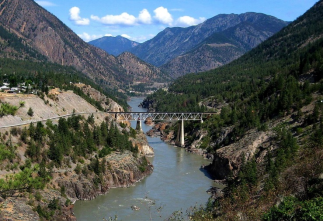
II.Natural Geography
₋Lillooet (English: /ˈlɪloʊ.ɛt/), formerly Cayoosh Flat, is a community on the Fraser River in British Columbia, Canada, about 240 ki lometres (150 mi) up the British Columbia Railway line from Vancouver. Situated at an intersection of deep gorges in the lee of the Coast Mountains, it has a dry climate with an average of 329.5 millimetres (13 in) of precipitation being recorded annually. Lillooet has a long growing season, and once had prolific market gardens and orchard produce. It often vies with Lytton and Osoyoos for the title of "Canada's Hot Spot" on a daily basis in summer.
₋Transportation
₋The Lillooet Railway Station is a former BC Rail Station. The station is served typically twice per week by the Kaoham Shuttle. There was formerly a service to North Vancouver, the Cariboo Prospector, but it was discontinued in 2002.
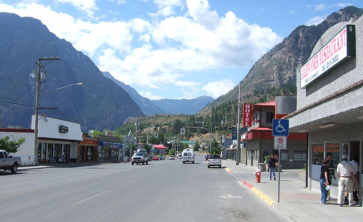
III.ECONOMY
₋The average salary for a Lifeguard is $18.22 per hour in Lillooet, BC, which is 11% above the national average. Salary estimates are based on 5 salaries submitted anonymously to Indeed by Lifeguard employees, users, and collected from past and present job advertisements on Indeed in the past 36 months. The typical tenure for a Lifeguard is less than 1 year.
₋Website: https://ca.indeed.com/salaries/lifeguard-Salaries,-Lillooet-BC
IV.Industrial Characteristics
₋Its economy was historically based around logging, the railway, ranching, farming, and government services. The town has had several booms and busts, relying on forestry since the mid-1970s although previous booms were connected with Fraser Canyon and Cariboo Gold Rushes, the building of the Lillooet Cattle Trail, another gold rush adjacent to town in the 1880s and another nearby in the Pacific Great Eastern Railway, and spinoffs from the development of the Bridge River goldfields from the 1910s onwards. Lillooet's economy also boomed in the 1940s and 50s during the construction of the Bridge River Power Project, which includes a dam, canal and powerhouse on the outskirts of town.
₋A new industry emerging in the area is wine, which was eyed early on by an Italian named Savona, for whom the town of Savona is named. His original vines were in the area of Fountain and were the first attempt at commercial wine-growing in British Columbia. Fort Berens Winery, located in East Lillooet across the Fraser from the main town, is a relatively new venture but has won several awards. A new winery at Cedar Falls, near Texas Creek about 20 km south of town on the west side of the Fraser, has been doing test plantations and will be commercially producing soon.
V.Attractions
1.Lillooet Museum and Visitor Centre
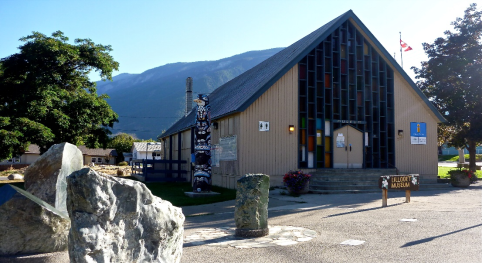
₋The Visitor Centre is situated in downtown Lillooet at St. Mary the Virgin, a former Anglican church. The original St. Mary's, which was torn down in 1960, stood on the same spot and arrived on the backs of miners and their mules, who carried the timber, piece by piece over the rugged Harrison-Lillooet trail in 1860. The original chancel was incorporated in the new St. Mary's and the melodeon and bell from the old church are displayed in the museum.
₋The visitor centre is the place to visit to gather local, regional and provincial information.
₋Phone: (250) 256-4308
₋Website: http://www.lillooetbc.ca/
2. Miyazaki House
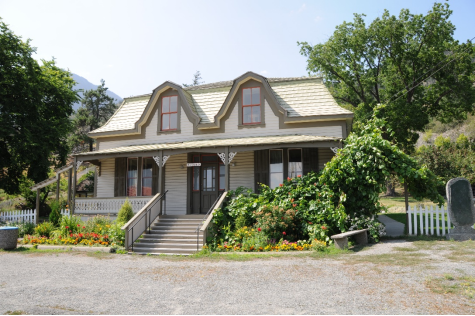
₋The Miyazaki House (formerly the Longford House) in Lillooet, British Columbia is an elegant house built by Caspar Phair in the 1880s. It was partially modelled after Mrs. Phair's previous home, Eyrecourt Castle, in County Galway, Ireland. The gardens originally reached down to Lillooet's Main Street. A.W.A. "Artie" Phair was next to live in the house, though he let the gardens deteriorate. In collaboration with the head of the local British Columbia Provincial Police, Phair brought Dr. Masajiro Miyazaki from the Bridge River relocation camp in Shalalth to Lillooet to replace the local coroner in 1945, and Miyazaki served in that capacity and, although only an osteopath by credentials, served in the capacity of doctor and dentist, and was living in Longford House in 1945. Dr. Miyazaki bought the house legally from Artie's son, Harold Phair, in 1947, when the ban on Japanese Canadians buying and owning property was lifted. The house was then used as Dr. Miyazaki's office until he donated it to the community of Lillooet in 1983.
₋The house is now called the Miyazaki House and is used for community events and local artwork display. It is also open as a Heritage House Tuesday to Saturday, 10–4, for free tours.
₋Phone: (250) 256-6808
₋Website: http://www.miyazakihouse.com/
3.Bridge of the Twenty-Three Camels
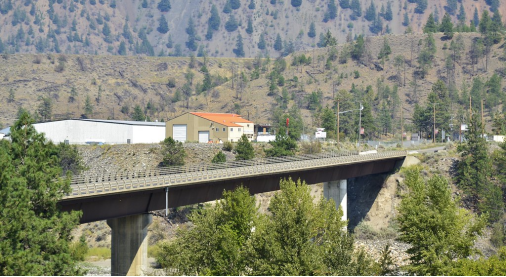
₋Bridge of the Twenty-Three Camels is the official name of the highway bridge over the Fraser River at Lillooet, British Columbia, Canada, on BC Highway 99. It replaced the older 1913-vintage Lillooet Suspension Bridge, just upstream, which had no highway designation but connected the town to BC Highway 12, a designation which today only refers to the Lillooet-Lytton highway but, until the extension of the 99 designation from Pemberton, also included the Lillooet-Cache Creek highway.
₋As something of a joke on this name, the crossing of the Yalakom River at Moha, a small concrete truss span, sports the sign "Bridge of the Twenty-Three Chipmunks".
₋Website: http://www.lillooetbc.ca/Arts,-Culture-Community/Historical-Sites.aspx
VI.History
₋Lillooet is an important location in Aboriginal history and culture and remains one of the main population centres of the St'at'imc (Lillooet Nation), and today it is one of the southernmost communities in North America where indigenous people form the majority. Just over 50 per cent of the people in Lillooet and area are St'at'imc. First Nations communities assert the land as traditional territory since time immemorial. Considered to be one of the oldest continuously inhabited locations on the continent, the area is reckoned by archaeologists to have been inhabited for several thousand years. The immediate area of the town attracted large seasonal and permanent populations of native peoples because of the confluence of several main streams with the Fraser and also because of a rock-shelf just above the confluence of the Bridge River which is an obstacle to migrating salmon. Many archaeological and heritage sites are in the vicinity of the town, including Keatley Creek Archaeological Site, one of the largest ancient pit-house communities in the Pacific Northwest.
₋This rock shelf, known in gold rush times as the Lower Fountain, was reputedly made by the trickster Coyote, leaping back and forth across the river to create platforms for people to catch and dry fish on. This location, named Sat' or Setl in the native language and known as the Bridge River Rapids or Six Mile in English, is the busiest fishing site on the Fraser above its mouth and there are numerous drying racks scattered around the banks of the river canyon around it.
₋Fraser Canyon Gold Rush
₋The town had its start as one of the main centres of the Fraser Canyon Gold Rush of 1858–59, during which it was reckoned to be "the largest town west of Chicago and north of San Francisco", a title also held by certain other towns in British Columbia in rapid succession (Yale first, Barkerville after). Just after this gold rush, the town's layout as it is today was surveyed by the Royal Engineers and its Main Street tied into the original Cariboo Wagon Road or Old Cariboo Road to Fort Alexandria, a huge project undertaken as a toll road by Gustavus Blin Wright, one of the many entrepreneurial personalities of the early colony. Much of its tortuous canyon-brink road grade for twenty or thirty kilometres from "Mile 0" remained in use until the 1970s. The route via the lakes to Lillooet and up Blin Wright's wagon road to the Cariboo goldfields was outflanked within a few years by the now-better known Cariboo Wagon Road via a shorter and less portage-intensive route from Yale to Barkerville via Ashcroft a few years later. Lillooeters still, however, consider their town to be "Mile 0" of the original Cariboo Wagon Road, and it is true that the numbered roadhouse names of the Cariboo district are measured from the bend in Main Street, where a cairn was erected to commemorate this fact. The first stretch of Main Street north from the cairn is said to point due north and at one time was called "the Golden Mile" partly because of all the gold dust reputed to be scattered along it in its heyday, and also because it was the hub of supply for the surrounding goldfields.
₋Lillooet was originally named Cayoosh Flat, a name that was felt to be unsavoury by the residents of the town at the time of its incorporation in 1860. Since it was at the end of the Lillooet Trail, aka the Douglas Road or Lakes Route, and the Lil'wat native people farther southwest along that route spoke the same language as the native bands near town, the governor was petitioned to change the name to Lillooet, with permission for use of the name granted by the chiefs of the Lower St'at'imc at Mount Currie (Lil'wat) and agreed to by the bands of what is now the Upper St'at'imc.
₋Other mining history
₋There have been a series of gold rushes in the surrounding region since the original one, including a large hard-rock one in the upper Bridge River Country which began in the 1880s and 1890s but had its peak from the 1930s to the 1950s, focussed on two main mining towns at Bralorne and adjacent Pioneer Mine and that area's main base town of Gold Bridge. Gold mining and prospecting continues in the area to this day, as do prospects for copper, silver and nephrite jade, though not to the same extent. Until the discovery of even larger deposits of jade near Cassiar, the Lillooet area was the world's largest source of the nephrite form of jade. Unknown tonnes were exported to China before government assayers discovered the nature of the "black rocks" that the Chinese miners found so interesting.
₋In the 1950s, local farmer and teacher Ron Purvis adapted the skil-saw concept by implementing a diamond rotary blade. This enabled the carving of the many immense jade boulders which line the banks and bed of the Fraser and Bridge Rivers, which were on the one hand immovable and on the other would shatter or striate if blasting was used to break them. Purvis' innovation was revolutionary in the jade mining business and larger versions of his saw are at use in the Cassiar region. There are no major commercial jade mines in the Lillooet area today, although local shops still carry polished jade souvenirs.
₋The Golden Cache Mine located on Cayoosh Creek just West of Lillooet was believed to hold one of the richest ore bodies of gold until lack of results ended investment, though it started a local prospecting boom with various miners and companies continuing the search for rich veins around the region. Most in town for the "Golden Cache boom" headed for the Klondike or Atlin by 1900.
₋Japanese relocation centres
₋There are a number of Japanese-Canadian families in Lillooet today who are descendants of those who remained in the area after their forced relocation to Lillooet and other nearby camps at Shalalth, Minto City and McGillvray Falls during World War II.
VII.Other Information
₋Education
₋Lillooet has one high school, Lillooet Secondary, which also serves students from rural localities outside the town such as Shalalth, Seton Portage, Gold Bridge and Bralorne although those communities do offer students a Secondary School program. Cayoosh Elementary School is located in the Cayoosh Heights subdivision and George M. Murray Elementary serves those in North Lillooet. The Upper St'at'imc Culture, Language and Education Society (USCLES) operates education programs, but most St'at'imc children attend the public school system. Post-secondary programs are offered by Thompson Rivers University located at 155 Main Street. The Fountainview Academy Association operates Fountainview Academy, an international private school, which offers work-study experience that includes organic farming, and is about 24 km south of Lillooet on British Columbia Highway 12.
VIII.Contact Information
₋Government
Mayor: Peter Busse
Governing body: District of Lillooet
₋City Hall
₋Address:
615 Main Street
PO Box 610
Lillooet, BC V0K 1V0
Main: (250) 256-4289
If you know the extension: (250) 256-7422 plus the Ext. No.
Fax: (250) 256-4288
E-Mail: cityhall@lillooetbc.ca
₋Website: http://www.lillooetbc.ca/Municipal-Government/Contact-Us.aspx
